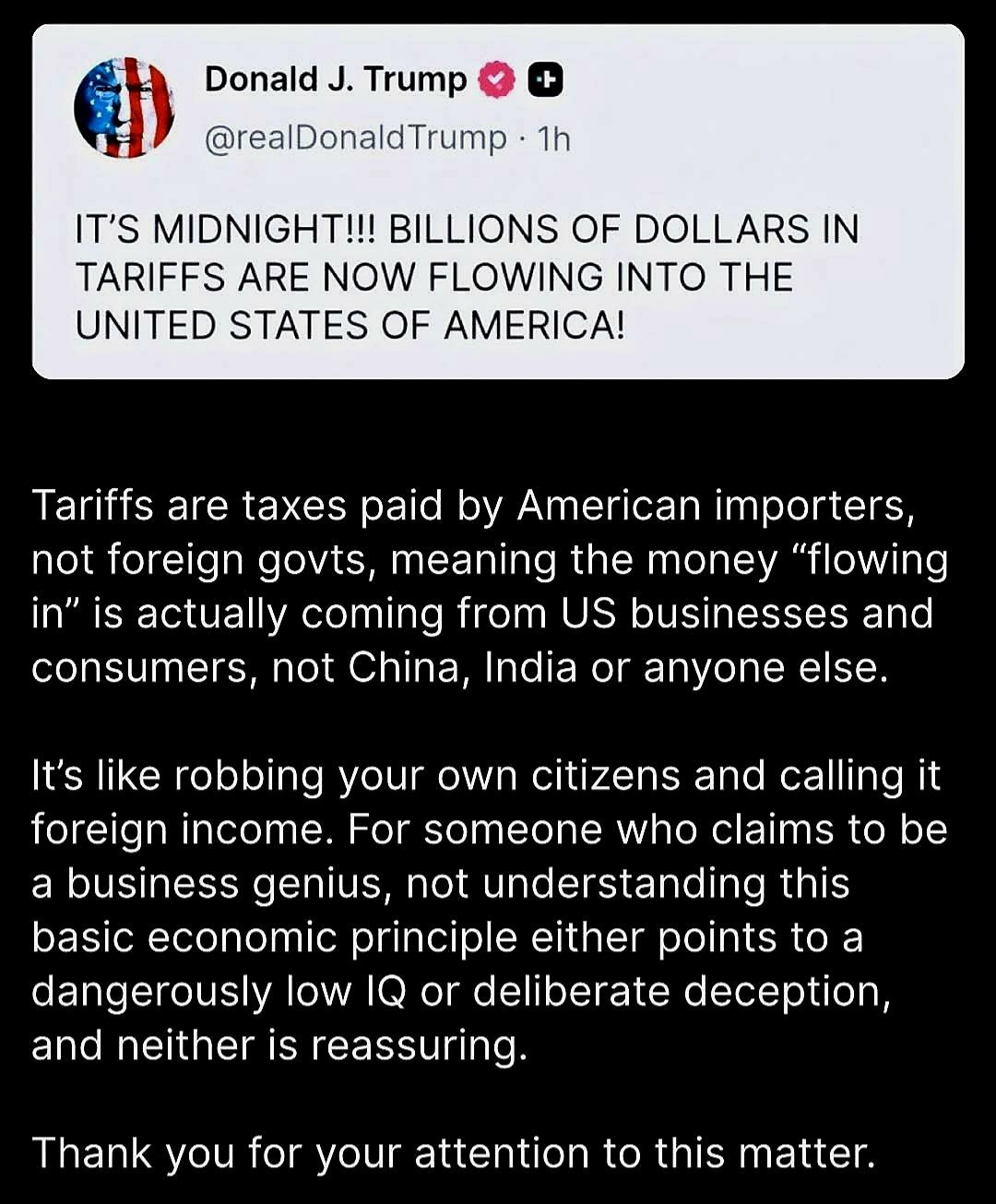Howdy Modi
India’s tiff with Trump
Tariffs are among the most potent tools in Donald Trump’s arsenal, precisely because they don’t require congressional approval. They bypass legislative gridlock and they can be imposed overnight. And most crucially, they allow Trump to pursue geopolitical goals under the guise of trade enforcement. He did it with China during his first term. Now, in 2025, he’s doing it again and this time with India in the crosshairs.
The move is consistent with Trump’s broader modus operandi: creating problems, negotiating and then offering to solve them on his terms. In this or rather his case, tariffs aren’t just about trade…they’re the blunt end of a diplomatic message and a statement of presidential autonomy. While Congress debates defense budgets or sanctions packages, Trump unilaterally reshapes U.S. economic relations with countries as large and complex as India.
But there’s a deeper irony here. Trump has spent years railing against the so-called “deep state,” accusing the bureaucratic apparatus of working against his agenda. Yet in his second term, he’s quietly constructing a parallel structure, a dark state of economic coercion and ad hoc diplomacy, centered around unilateral executive tools like tariffs, sanctions waivers, and opaque backroom dealings. This is a personalist trade regime where punishment and exemption are dictated from the top, often based on loyalty, optics, or transactional value. MAGA!
Anyway, our topic of discussion is India being the target.
So why India?
The official reason for the August 2025 tariff hike given for an additional 25 percentage points on top of existing duties is India’s continued purchase of discounted Russian crude. But that’s only part of the story. Trump’s frustration with India is layered. At the top is a deep-seated belief that New Delhi isn’t treating Washington as its principal strategic partner.
In Trump’s view, India has made too many hedges: buying cheap oil from Moscow while courting U.S. defense contracts; attending Quad summits while refusing to back U.S.-led votes in the Russia-Ukraine case; and pursuing market access in the U.S. while maintaining steep protective tariffs at home. His criticism of Indian trade policy is long-standing. As far back as 2018, Trump mocked Indian duties on Harley-Davidson motorcycles and called India the “tariff king.” That sentiment, apparently, never left.
Then there’s a more personal grudge. During the India-Pakistan confrontation early this year, Trump believes his intervention helped avert a larger conflict. Yet India gave him no public credit. Modi’s government framed the de-escalation as a unilateral move, sidestepping any acknowledgment of American involvement. For Trump, who views diplomacy as performance and demands recognition, that omission rankled..and Pakistan took this opportunity to please trump by nominating him for the Nobel. How noble!
India’s Bind: Geography, Geopolitics, and China
India’s refusal to fully align with Washington is not indecision, it is a deliberate strategy shaped by geography, history, and economic realities.
Unlike America’s treaty allies, India faces an immediate and dangerous neighborhood: to its west, Pakistan remains a nuclear-armed spoiler closely tied to Beijing; to its north and east, China is a far stronger rival with territorial claims and a history of military clashes. These threats are daily realities that no external power, including the U.S., can manage on India’s behalf.
At the same time, India’s economy remains deeply dependent on China, which supplies critical inputs for sectors like pharmaceuticals, electronics, and telecom equipment. While Washington calls for “decoupling” from China, it is easier said than done both for the US and for India.
Then there is Russia: while the U.S. views Moscow as an adversary, India continues to rely on Russia for discounted oil, advanced defence equipment, and as a partner that does not interfere in its domestic or foreign policies. Abandoning Moscow under U.S. pressure would weaken India’s security readiness and push Russia even closer to China, something New Delhi cannot afford.
Beyond these calculations lies a bigger difference in worldview. Washington often sees the world in black and white - democracies versus autocracies, allies versus rivals; but India operates in a far more fluid and multipolar region. It needs flexibility: the ability to cooperate with the U.S. in the Indo-Pacific, trade with China despite rivalry, and maintain defence ties with Russia. This balancing act is not weakness; it is necessity.
Domestic politics also matter. Indian public opinion places a high value on sovereignty and independence, and any government seen as bending too far to Washington or putting farmers and the agri sector in jeopardy, risks losing legitimacy at home. Memories of colonial subjugation still shape how India approaches foreign powers, making it unwilling to accept external dictates. For these reasons, what some in Washington dismiss as India’s hesitation is, in reality, a carefully thought-out survival strategy. Strategic autonomy allows India to keep its options open, avoid over-dependence on any single power, and shape its future based on its own interests rather than the priorities of distant capitals.
Coming back to tariffs…
The recent tariffs hit hard where India is most competitive and most exposed. Textiles, apparel, home furnishings, auto parts, gems and jewelry - all face effective duties nearing 50%. These sectors are labor-intensive and highly dependent on U.S. demand. For example, India is the single largest supplier of home linens to the U.S., accounting for over a third of the market. In apparel, Indian exporters now face a 30 - 40% cost disadvantage versus Vietnam or Bangladesh. U.S. buyers are already rerouting orders.
Gems and jewelry have also taken a blow. India’s diamond industry, centered in Surat and Mumbai, was shipping over $10 billion annually to the U.S. Much of that now risks being displaced by competitors in Turkey, Thailand, and even China.
Auto components for commercial vehicles, a fast-growing export niche, now face steep headwinds. Indian suppliers serving OEMs like Caterpillar and Ford must either absorb the cost or cede share to Mexico or East Asia. For firms already squeezed by currency volatility and rising input costs, the margin hit could be existential.
Sectors which are spared like smartphones and pharmaceuticals offer a window into Washington’s calculus. Apple relies heavily on Indian assembly lines. The U.S. also depends on Indian generics for affordable healthcare. Sparing these reflects self-interest, not goodwill. But it also exposes the asymmetry in India’s export portfolio: where dependence runs both ways, India survives. Where it doesn’t, India bleeds.
Can India Weather the Shock?
In the short term, the damage will be acute. Exporters are facing cancellations. Forward bookings have slowed. Analysts already see downward revisions in India’s 2025–26 GDP forecasts - from 6.5% to below 6%. The rupee has declined and investor confidence, especially in export-linked manufacturing, is wavering.
Yet India is not without buffers.
First, global buyers will not rewire sourcing overnight. While Vietnam and Bangladesh offer alternatives, India remains the only country with the scale, quality, and infrastructure to support large-scale exports in certain categories. Some U.S. firms may absorb part of the cost rather than switch suppliers immediately.
Second, India is using this shock to accelerate diversification. Bilateral trade talks with the EU and the UK are gaining urgency. Domestically, policymakers are exploring targeted subsidies and credit support to keep exporters afloat during the transition.
Third, this could deepen India’s push for long-term supply chain self-reliance. The PLI (Production-Linked Incentive) schemes were already designed to reduce dependency on China and move up the value chain. Now, they carry geopolitical urgency.
Strategic Autonomy - Under Pressure, But Intact
New Delhi has not stood still. Its response to the tariff barrage has followed a pragmatic path: engage, but don’t capitulate. Indian negotiators have offered selective concessions - lower tariffs on U.S. goods, new energy contracts, increased defense procurement while drawing firm lines around agriculture and politically sensitive sectors.
At the same time, India is keeping lines open with China, not in pursuit of alignment, but in pursuit of breathing room. Defense Minister Rajnath Singh’s June trip to Shanghai and Modi’s scheduled SCO attendance signal a bid to avoid antagonizing both superpowers at once.
Meanwhile, India is widening its trade aperture. FTAs with the UK, EU, and New Zealand are gaining traction. Agreements with BRICS members like Brazil and South Africa are being dusted off. The aim is clear: to insulate India from Washington’s volatility and Beijing’s leverage.
The bigger question. Will these tariffs force India to bend? Unlikely.
India may offer tactical accommodations such as modest oil import curbs, limited tariff reductions but its core strategy won’t shift. Strategic autonomy is a function of necessity, not ideology. It’s how India navigates a world that offers no permanent allies, only shifting alignments.




